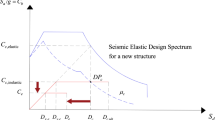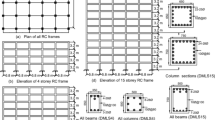Abstract
This paper presents the probabilistic seismic demand and fragility analyses of a novel mid-rise large-span cassette structure. A newly designed nine-storey office building in Hunan, China, is selected, and its two different design schemes, namely, a traditional frame structure and a novel cassette structure, are examined using numerical models established on the basis of a shake table test. Based on probabilistic seismic theory, the appropriate intensity measures are firstly studied based on a set of 110 seismic records; and PGV and GeoSaavg, which consider the 3D characteristics of the structure, are selected. In addition, the uncertainty of earthquakes, including spectral characteristics, fault distance and input direction, are considered, and 25 seismic records recommended by the Federal Emergency Management Agency are selected. An incident angle interval of 22.5° is selected to consider the uncertainty in the input directions of real earthquakes. Incremental dynamic analyses are conducted, and the structural responses in every individual input direction as well as in all the directions are studied. Finally, probabilistic seismic fragility analysis is conducted, and the probabilities of exceeding different limit states of the frame and cassette structures is presented. Amongst the studies, the novel cassette design can not only achieve much larger span, but also shows a better, more stable seismic performance. Therefore, the cassette structure may be a better alternative in seismic design.



















Similar content being viewed by others
Availability of data and material
All data generated or analyzed during this study are included in this article, and the datasets used or analyzed during the current study are available from the corresponding author on reasonable request.
Code availability
There is no code used in this research.
References
Ali MM, Moon KS (2007) Structural developments in tall buildings: current trends and future prospects. Archit Sci Rev 50(3):205–223
Applied Technology Council (2008) Quantification of building seismic performance factors. ATC-63 Project Report
Avci-Karatas C (2019) Prediction of ultimate load capacity of concrete-filled steel tube columns using multivariate adaptive regression splines (MARS). Int J Steel Composite Struct 33(4):583–594
Cao S, Ma K, Wei Y, Jiang H (2013) Application of large span precast cassette structure in industrial architecture. Build Struct 43(4):38–41
Cao X, Feng D, Wu G (2019) Seismic performance upgrade of RC frame buildings using precast bolt-connected steel-plate reinforced concrete frame-braces. Eng Struct 195:382–399
Celik OC, Ellingwood BR (2010) Seismic fragilities for non-ductile reinforced concrete frames—role of aleatoric and epistemic uncertainties. Struct Saf 32(1):1–12
Chang S (2010) Experimental studies of reinforced concrete bridge columns under axial load plus biaxial bending. J Struct Eng 136(1):12–25
Chen ZP, Wu G, Feng DC, Ma KJ (2018) Numerical study of the static and dynamic characteristics of reinforced concrete cassette structures for high-rise buildings. Struct Des Tall Spec Build 28(3):e1574
Chen Z, Feng D, Wu G, Ma K (2020a) Experimental study of a novel open-web sandwich slab and modified design procedure. Mag Concr Res 1–20
Chen Z, Feng D, Wu G (2020b) Seismic performance and design process majorization of a reinforced concrete grid frame wall, J Earthq Eng 1–30
Chen Z, Feng D, Ke-Jian M, Wu G (2021) Shaking table test and evaluation of a novel high-rise large span concrete cassette structure. Eng Struct 238:112205
Cornell CA (2002) The probabilistic basis for the 2000 SAC/FEMA steel moment frame guidelines. ASCE J Struct Eng 128(4):526–533
DOCG (Department of Construction, Guizhou) (2005) Technical specification for reinforced concrete open-web sandwich plate structures. China Architecture Publishing & Media Co. Ltd., Guiyang
DOCH (Department of Construction, Heilongjiang) (2014) Technical specification for reinforced concrete space griding structure with open-web sandwich plate. China Architecture Publishing & Media Co. Ltd., Haerbin
Dong Y, Frangopol DM, Saydam D (2013) Sustainability of highway bridge networks under seismic hazard. J Earthq Eng: JEE 18(1):41–66
Fan JJ, Wu G, Xu AL, Feng DC, Chen ZP (2020) Experimental study on the seismic performance of novel precast reinforced concrete grid moment-resisting frames. Struct Concr: J FIB 21(5):2028–2043
Federal Emergency Management Agency (2000) Prestandard and commentary for the seismic rehabilitation of buildings. American Society of Civil Engineering
Feng DC, Wu G, Sun ZY, Xu JG (2017) A flexure-shear timoshenko fiber beam element based on softened damage-plasticity model. Eng Struct 140:483–497
Feng D, Xie S, Deng W, Ding Z (2019) Probabilistic failure analysis of reinforced concrete beam-column sub-assemblage under column removal scenario. Eng Fail Anal 100:381–392
Hariri-Ardebili MA, Saouma VE (2016) Probabilistic seismic demand model and optimal intensity measure for concrete dams. Struct Saf 59:67–85
Jia J, Zhang K, Wu S, Guo Y, Du X, Wang X (2020) Seismic performance of self-centering precast segmental bridge columns under different lateral loading directions. Eng Struct 221:111037
Lervolino I, Cornell CA (2005) Record selection for nonlinear seismic analysis of structures. Earthq Spectra 21(3):685–713
Ma K, Zhang H, Zheng T (2006) Theory and practice of new type architectural space griding structures. China Communication Press, Beijing
Ma K, Zhang H, Xiao J (2008) Concrete space grid structure. J Build Struct 29(S1):239–245
Medina R, Krawinkler H (2003) Seismic demands for nondeteriorating frame structures and their dependence on ground motions. Pacific Earthquake Engineering Research Center, Berkeley
Menegotto M (1973) Method of analysis for cyclically loaded R. C. plane frames including changes in geometry and non-elastic behavior of elements under combined normal force and bending. In: Proceedings of IABSE symposium on resistance and ultimate deformability of structures acted on by well defined repeated loads1973, pp 15–22
MHURD (Ministry of Housing and Urban-Rural Development of China) (2010) Code for seismic design of buildings. China Architecture Publishing & Media Co. Ltd., Beijing
MHURD (Ministry of Housing and Urban-Rural Development of China) (2010) Code for design of concrete structures. China Architecture Publishing & Media Co. Ltd., Beijing
Padgett JE, Nielson BG, DesRoches R (2008) Selection of optimal intensity measures in probabilistic seismic demand models of highway bridge portfolios. Earthq Eng Struct D 37(5):711–725
Qian J, Dong Y (2020) Multi-criteria decision making for seismic intensity measure selection considering uncertainty. Earthq Eng Struct D 49(11):1095–1114
Rodrigues H, Arêde A, Varum H, Costa AG (2013a) Experimental evaluation of rectangular reinforced concrete column behaviour under biaxial cyclic loading. Earthq Eng Struct D 42(2):239–259
Rodrigues H, Arêde A, Varum H, Costa A (2013b) Damage evolution in reinforced concrete columns subjected to biaxial loading. Bull Earthq Eng 11(5):1517–1540
Rodrigues H, Furtado A, Arêde A, Vila-Pouca N, Varum H (2018) Experimental study of repaired RC columns subjected to uniaxial and biaxial horizontal loading and variable axial load with longitudinal reinforcement welded steel bars solutions. Eng Struct 155:371–386
Scott BD, Park R, Priestley M (1982) Stress-strain behavior of concrete by overlapping hoops at low and high strain rates. ACI J 79(1):13–27
Shafieezadeh A, Ramanathan K, Padgett JE, Desroches R (2012) Fractional order intensity measures for probabilistic seismic demand modeling applied to highway bridges. Earthq Eng Struct D 41:391–409
Ucak A, Tsopelas P (2014) Load path effects in circular steel columns under bidirectional lateral cyclic loading. J Struct Eng 141:04014133
Vamvatsikos D, Cornell CA (2002) Incremental dynamic analysis. Earthq Eng Struct D 31(3):491–514
Wang X, Shafieezadeh A, Ye A (2017) Optimal intensity measures for probabilistic seismic demand modeling of extended pile-shaft-supported bridges in liquefied and laterally spreading ground. Bull Earthq Eng 16(1):229–257
Ye Z, Feng D, Wu G (2019) Seismic control of modularized suspended structures with optimal vertical distributions of the secondary structure parameters. Eng Struct 183:160–179
Ye Z, Shafieezadeh A, Sezen H, Wu G, Feng DC (2020a) Cross-level fragility analysis of modularized suspended buildings based on experimentally validated numerical models. Struct Des Tall Spec Build 29(14):e1778
Ye Z, Wu G, Feng D, Shafieezadeh A (2020b) Shake table testing and computational investigation of the seismic performance of modularized suspended building systems. Bull Earthq Eng 18(11):5247–5279
Acknowledgements
The authors greatly appreciate financial support from the National Natural Science Foundation of China (Grant Numbers 51838004, 51525801 and 51708106) and the Natural Science Foundation of Jiangsu Province (Grant Number BK20170680).
Funding
The research is supported by the National Natural Science Foundation of China (Grant Nos. 51838004, 51525801 and 51708106) and the Natural Science Foundation of Jiangsu Province (Grant No. BK20170680).
Author information
Authors and Affiliations
Contributions
Z-PC: Methodology, investigation, data curation, conceptualization, writing—original draft; D-CF: project administration; X-YC: data collecting; K-JM: investigation, supervision; SZ: writing—review and editing; GW: validation, resources.
Corresponding author
Ethics declarations
Conflict of interest
The researchers claim that there is no conflict of interest in this research.
Additional information
Publisher's Note
Springer Nature remains neutral with regard to jurisdictional claims in published maps and institutional affiliations.
Rights and permissions
About this article
Cite this article
Chen, ZP., Feng, DC., Cao, XY. et al. Probabilistic seismic demand and fragility analysis of a novel mid-rise large-span cassette structure. Bull Earthquake Eng 20, 383–413 (2022). https://doi.org/10.1007/s10518-021-01222-w
Received:
Accepted:
Published:
Issue Date:
DOI: https://doi.org/10.1007/s10518-021-01222-w











